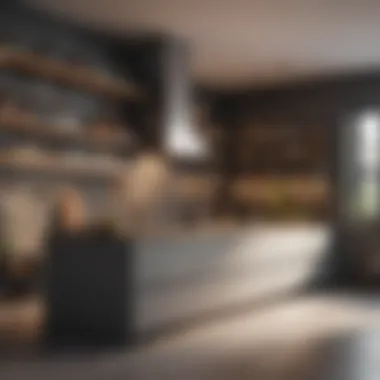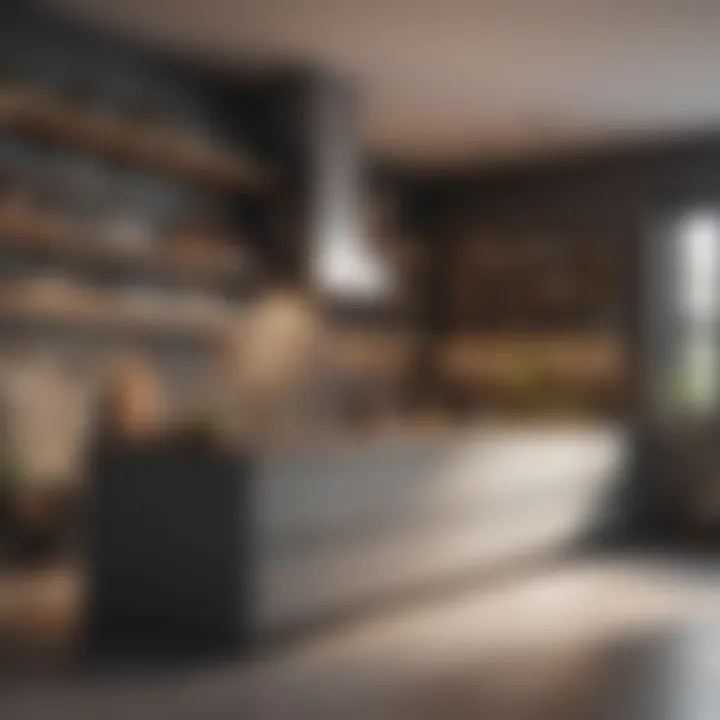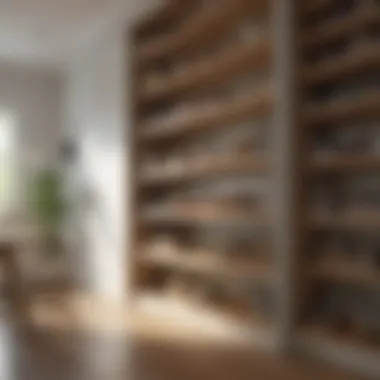Maximizing Kitchen Space with Open Pantry Storage


Intro
Open pantry storage is a modern solution that offers not only functionality but also aesthetic appeal to kitchens. In contrast to traditional closed cabinets, open pantry systems encourage accessibility and visibility, enabling homeowners and cooking enthusiasts to quickly find what they need. This comprehensive guide explores various aspects of open pantry storage, focusing on its benefits, practical implementation, and design considerations. By understanding these elements, one can create a space that is both organized and visually pleasing.
This article aims to dive deep into trending styles, color palettes, maintenance tips, budgeting, and planning methods, offering practical insights for homeowners and design enthusiasts alike. The multi-faceted approach ensures that readers gain a thorough understanding of how to maximize their kitchen areas, enhance accessibility, and establish a well-organized aesthetic.
Preamble to Open Pantry Storage
Open pantry storage has emerged as a defining feature in modern kitchens. This design choice provides not only practical benefits but also enhances the overall kitchen aesthetic. Homeowners and design enthusiasts alike are embracing this trend, driven by a desire for more accessible and visually appealing storage solutions. An open pantry allows for clear visibility of stored items, promoting a sense of organization and ease of access.
The importance of this topic lies in its multifaceted advantages. Open pantries simplify ingredient selection while cooking, eliminate the need for constant rummaging through opaque cabinets, and facilitate better inventory management. Furthermore, they can serve as a display area for decorative jars, cookbooks, or even plants, making functional use of space.
One cannot overlook the considerations when opting for open pantry storage. While it is visually appealing, it does require commitment to maintain order and cleanliness. Unlike closed cabinetry, an open pantry demands regular upkeep to avoid accumulating dust and clutter. It is imperative for homeowners to think through design choices and organization strategies, ensuring their open pantry stays both functional and stylish.
Understanding the Trend
The trend of open pantry storage reflects a broader shift in kitchen design towards open-concept living spaces. As families engage in cooking and entertaining in shared areas, the need arises for storage solutions that blend functionality with style. Open pantries prioritize accessibility while inviting guests into the kitchen, signaling a movement towards communal culinary experiences. This trend recognizes that kitchens are no longer just workspaces; they are the heart of the home, deserving thoughtful design.
Additionally, the rise of meal prepping and healthy eating has generated an interest in clear organization. With an open pantry, individuals can quickly assess their resources and plan meals more efficiently. The result is a blend of practicality and creativity, allowing home cooks to showcase both ingredients and artistry.
Defining Open Pantry Storage
Open pantry storage can be best described as an accessible area in the kitchen that displays food and cooking essentials without the barriers of traditional cabinetry. This setup may include shelves, racks, or even dedicated cabinets designed for visibility. Items like spices, grains, and canned goods are showcased, encouraging their use and promoting freshness.
Typically situated within arm's reach, open pantries empower homeowners to maintain an organized kitchen effortlessly. The storage layout can vary widely, from minimalist floating shelves to more elaborate built-in units.
The key distinction of open pantry storage is the removal of cabinet doors, which cultivates a more inviting atmosphere. It encourages efficiency and adaptability while supporting personal style and taste. By carefully considering one’s needs and kitchen layout, anyone can create an open pantry space that meets both practical requirements and aesthetic desires.
Benefits of Open Pantry Storage
Open pantry storage presents multiple advantages that enhance both the functionality of a kitchen and the overall living experience. A pantry without closed doors allows easy access to items, streamlining daily routines. Homeowners often find themselves benefiting greatly from such configuration. The open concept encourages users to maintain organization, as visible items prompt regular tidying. Additionally, it can transform how a kitchen is perceived in terms of decor and space utilization.
Enhanced Accessibility
Accessibility is a primary advantage of open pantry systems. It allows for easy retrieval of ingredients and tools that you use most often. This can be particularly valuable during meal preparations when time is often scarce. Without rummaging through cabinets, users can see everything laid out in a clear manner.
Comparative Analysis:
- Difficult access with closed cupboards.
- Immediate visibility with open shelves.
The organized layout can reduce frustration and improve efficiency during cooking, as all needed items are right in view. So, with an open pantry, reaching for that can of tomatoes or grabbing a fresh herb becomes quick and convenient.
Aesthetic Appeal
The visual impact of an open pantry cannot be understated. It encourages creativity in design. Homeowners can personalize the look and feel of their kitchens. Displaying attractive containers, jars, and labels contributes to a visually pleasing atmosphere. This not only elevates the kitchen experience but serves as a conversation starter during gatherings or family meals.
A well-organized open pantry can also reflect personal style, integrating beautifully with other kitchen elements. From minimalistic to rustic styles, every design intent can find a place in an open pantry setup. It can also contribute to an overall sense of larger, more open space through design.
Space Efficiency
Utilizing an open pantry effectively can maximize limited kitchen space. Shelving can be adjusted to fit different items. Consequently, vertical storage becomes more prominent, ensuring that even small kitchens can be utilized intelligently. Wide shelving can help in accommodating larger containers, thus significantly enhancing food storage solutions.
An effective open pantry design can also eliminate the clutter often associated with traditional storage options. Items that may have been squeezed into tight cabinets can be laid out openly. When organized properly, this design helps homeowners make the most of their kitchen square footage, resulting in a harmonious flow of movement during daily tasks.
Open pantry storage systems enhance accessibility, aesthetic appeal, and efficient space usage in kitchens.
Choosing the Right Location
The placement of your open pantry storage is critical to the overall effectiveness and functionality of your kitchen. An open pantry is not simply a decorative element but also a practical space for easy access to your cooking essentials. Poorly chosen locations can hinder usability and complicate kitchen tasks, while the right location can transform your cooking experience.
Evaluating Kitchen Layout
Before deciding on a spot for your open pantry, assess the kitchen layout. This involves understanding the workflow in your kitchen, which commonly follows the triangle method—convenient movements between the sink, stove, and refrigerator. An open pantry should not disrupt this flow. Place it where you can easily reach it without stepping away from the main cooking area.
Consider the following:


- Adjacent Working Zones: Is the pantry close to the preparation area? This makes grabbing ingredients quick and easy.
- Natural Movement Patterns: Observe how you move in your kitchen. A location in harmony with your movement patterns enhances overall efficiency.
- Accessibility During Meal Prep: Ensure your pantry placement allows easy visibility and accessibility to all items, especially when multitasking in the kitchen.
Choosing a location requires not only an understanding of space but also the readiness to adapt to your culinary habits.
Identifying Available Space
After evaluating the kitchen layout, the next step is to identify available space for the open pantry. This means looking for underutilized areas that can serve as a pantry without crowding the kitchen.
Here are factors to consider:
- Corner Spaces: Often neglected, corner spaces can be adapted into functional pantry areas. Shelving units can fit snugly in these corners, optimizing space efficiently.
- Vertical Storage Options: Use wall-mounted shelves to make the most of vertical space. This allows you to store more without sacrificing floor area.
- Recessed Areas: If your kitchen has any recessed areas or indentations, consider transforming them into custom pantry nooks. This adds character without taking up useful space.
It’s important to measure the available dimensions carefully. Planning the space will determine the style and organization of your pantry.
Key Takeaway: Choosing the right location for your open pantry storage is essential not only for aesthetics but also for maximizing functionality and maintaining kitchen order.
By making informed decisions about the layout and available space, you create an optimal environment for your pantry, ultimately enhancing both efficiency and style in your cooking area.
Design Considerations for Open Pantries
When planning an open pantry, design considerations are crucial. They influence both functionality and aesthetic appeal. A well-thought-out design can enhance organization, make items easier to find, and harmonize with existing kitchen styles. The following sections explore the selection of materials and stylistic choices, each vital for a successful pantry setup.
Selecting Materials
Wood Options
Wood is a popular choice for open pantry storage due to its warm and inviting appearance. Its versatility allows it to complement various kitchen designs. Different types of wood can provide distinct finishes, from polished to distressed. One key characteristic of wood is its robustness; it can handle a lot of weight, making it suitable for bulky items like cookbooks and large jars.
However, wood requires maintenance to prevent damage from moisture. Regular sealing protects it from humidity and stains. Despite this, the natural aesthetic of wood can create a cozy atmosphere in the kitchen, appealing to many homeowners.
Metal Choices
Metal offers a modern, sleek look for open pantries. This material is often chosen for its durability and ease of cleaning. Stainless steel and powder-coated options can resist tarnishing and rust, making metal a practical choice in high-use areas. One unique advantage of metal shelving is its ability to support heavy loads without sagging.
However, metal can sometimes give a cold feeling to the design. To combat this, it’s beneficial to mix materials, such as incorporating wooden accents. This combination keeps the space feeling warm while still achieving a contemporary vibe.
Glass Features
Glass brings a transparent quality that can make a pantry feel more open and spacious. Shelving made from tempered glass allows visibility of items, encouraging organization. This material is favored for its lightweight nature and smooth surface, making it easy to clean. Moreover, glass can enhance light flow in the area, brightening the overall appeal.
Despite its advantages, glass can be fragile. Care must be taken to avoid heavy impacts. Additionally, fingerprints can be more visible on glass, requiring regular cleaning to maintain its aesthetic. Overall, the use of glass can elevate the style of an open pantry significantly.
Choosing a Style
When selecting a style for an open pantry, it is essential to consider how it fits within the larger kitchen aesthetic.
Modern Designs
Modern designs focus on clean lines and minimalism. Open pantries in this style feature simple cabinetry and uncluttered layouts. The emphasis is on functionality without unnecessary ornamentation. This style is appealing for those who appreciate a contemporary look and feel in their kitchen.
Its unique feature is the use of space. Modern designs often integrate multi-functional elements, which aid in maximizing organization. However, minimalism can risk a sterile appearance if not balanced with decorative elements.
Rustic Appeal
Rustic design brings warmth and a homey vibe to open pantries. This style often includes reclaimed wood, vintage accessories, and a cozy layout. One key characteristic is the use of natural materials, which can create a lived-in feel.
The unique advantage of rustic appeal is its ability to blend with a variety of styles. It can be both charming and practical. However, the challenge may lie in maintaining a coherent look, as excessive decoration can lead to visual clutter.
Minimalist Approach
The minimalist approach extends beyond modernity, focusing on essentialism. In open pantries, this style strips down to basics, avoiding excess items. The result is a clean, organized space where each item has its place.
A major advantage of minimalism is stress reduction. A clean environment can promote a sense of calm. However, achieving a minimalist look can require ongoing effort to prevent clutter from accumulating over time. Therefore, implementing regular organizational practices becomes vital.
One never underestimates the impact of design choices in functional areas like pantries, influencing both utility and comfort in daily routines.


By carefully considering materials and styles, homeowners can create open pantries that not only serve practical purposes but also enhance the overall kitchen experience.
Organizing Open Pantry Storage
Organizing an open pantry is pivotal for ensuring that the space remains functional and visually appealing. Efficient organization improves accessibility to supplies, leading to a smoother cooking experience. When items are categorized appropriately, it minimizes time spent searching for what is needed, enhancing the overall efficiency of the kitchen.
Effective organizing also helps in maintaining an aesthetic appeal. A well-ordered pantry contributes to the beauty of the kitchen design, complementing the overall decor. Homeowners should view open pantry organization as a continual process, requiring regular updates and adjustments based on usage patterns.
Categorizing Items
Categorizing items in an open pantry involves grouping similar products together, which not only improves accessibility but also promotes efficiency. It is sensible to create sections for dry goods, canned items, spices, and snacks. This approach simplifies the retrieval process during cooking and meal preparation.
Furthermore, implementing a logical categorization system can prevent overstocking or wastage of items. When everything has its designated place, it is easier to see what needs restocking. Consider using a system that works best for your habits and routines, be it alphabetical, by expiration date, or by frequency of use.
Using Containers and Bins
Using containers and bins is an effective way to enhance the organization of an open pantry. They provide a tidy look while ensuring that items do not spill or become disorganized. Here are important points to consider regarding material options and labeling strategies.
Material Options
When selecting materials for containers and bins, plastic and glass are two popular choices, each with its own set of characteristics. Plastic bins are lightweight and often come in a variety of sizes and colors. Their affordability makes them an attractive option for many homeowners looking for budget-friendly solutions. However, they might not provide the same level of durability as glass.
On the other hand, glass containers are more durable and provide a view of contents, which can be visually appealing. They’re often considered eco-friendly as they do not retain odors, and they can withstand heating or freezing. However, they can be heavier and more prone to breakage than plastic. The choice of material can significantly affect the overall functionality of the open pantry space.
Labeling Strategies
Implementing effective labeling strategies is crucial for maintaining order in an open pantry. Labels provide clear indications of contents, assisting both household members and guests. Reusable labels are a popular choice because they can be updated easily as items are replaced.
Furthermore, using uniform labels can add a cohesive design element to the pantry. A unique feature of labels is that they not only assist in organization but also can enhance the aesthetic appeal of the space. The downside is that labels can occasionally peel off or fade over time, necessitating regular upkeep. Nevertheless, thoughtful labeling is an essential practice that promotes an organized atmosphere.
Maintaining Order in Open Pantry Spaces
Maintaining order in open pantry spaces is crucial for both functionality and aesthetics. A well-organized pantry not only enhances the visual appeal of the kitchen but also improves accessibility to items. When everything has its designated place, it reduces time spent looking for products and minimizes stress during meal preparation. Moreover, a tidy pantry can directly impact food safety by preventing spoilage and cross-contamination.
Regular Cleaning Routines
Establishing regular cleaning routines is an essential step in maintaining an orderly open pantry. Regular cleaning ensures that dust, crumbs, and spills do not accumulate over time. Homeowners should aim for a cleaning schedule that fits their lifestyle, whether it entails deep cleaning every month or quick tidies on a weekly basis. The process can be simplified by following these steps:
- Clear the Shelves: Remove all items from the pantry. This allows you to assess what you have and clean more effectively.
- Dust and Wipe Down: Use a dry cloth to dust shelves, and follow up with a damp cloth to remove any sticky residue.
- Check Expiration Dates: Discard expired products and consider donation for items that are still good but rarely used.
- Clean Containers: For items in bins or jars, take the time to clean these vessels. This prevents cross-contamination and keeps everything hygienic.
Consistent cleaning not only maintains order but also instills a sense of pride in the kitchen space.
Restocking and Inventory Management
Restocking and inventory management are fundamental components of an effective open pantry system. Keeping track of items not only ensures you have what you need, but it also helps prevent overbuying and saves money. Here are some strategies to refine this aspect:
- Create a Roster: Maintain a list of pantry items, noting quantities and expiration dates. This allows for easy updates and helps in planning grocery trips.
- FIFO Principle: Implement the First In, First Out principle. Place newer items behind older ones to ensure older products are used first.
- Visual Cues: Use jars or clear containers to allow visibility of stock levels. When you see that a jar is running low, it's a reminder to restock.
- Monthly Assessment: Set aside time each month to evaluate what you've used and what needs replenishing. This reduces the likelihood of discovering expired items hidden at the back.
By employing these inventory management techniques, one can ensure a functional, organized open pantry that serves its intended purpose efficiently.
Integrating Open Pantry with Kitchen Design
The integration of open pantry storage within kitchen design has become increasingly relevant in modern home layouts. Not only does it enhance functionality, but it also contributes to the overall aesthetic of your culinary space. A well-designed open pantry can become a focal point in the kitchen, effectively blending style with practicality. Homeowners and design enthusiasts alike should consider how their pantry fits within the broader narrative of the kitchen.
Harmonizing Colors and Textures
Color and texture play crucial roles in creating a seamless look when integrating an open pantry into kitchen design. Selecting a color palette that complements existing elements helps in visually linking the pantry and kitchen. For instance, if the kitchen features warm wood tones, an open pantry crafted from similar materials will feel more cohesive. Conversely, if the kitchen has a contemporary feel with sleek, white cabinetry, an open pantry in a matching finish can enhance the modern elegance of the entire space.
In addition to color, texture is also essential. Consider using materials that mirror those in the kitchen, such as glass jars to match shiny appliances, or rustic wood that harmonizes with farmhouse styles. When varied textures are complemented by color, it elevates the overall appeal of the kitchen.
Creating Cohesion with Existing Decor
Creating cohesion with existing decor is vital for a unified look. An open pantry should not only serve a utilitarian purpose but also resonate with the decor already present in the kitchen. For example, if your kitchen leans towards a minimalist aesthetic, keep open shelving simple and sparsely populated with essential items. This not only enhances functionality but also keeps visual clutter to a minimum.
In contrast, if the decor includes vibrant colors or eclectic elements, consider showcasing decorative containers or colorful dishware within the open pantry. This will create a sense of harmony while ensuring that the open pantry adds character without overwhelming the space.


"A well-structured pantry can enhance both the functionality and the aesthetics of a kitchen, making it an integral part of the design."
In summarizing these points, prioritizing cohesiveness in color and texture while aligning with the existing decor leads to a well-integrated open pantry. This thoughtful approach ensures that the pantry is not just an afterthought but an essential aspect of the kitchen's design."
Common Challenges and Solutions
Understanding the common challenges associated with open pantry storage is critical for anyone looking to maximize functionality and aesthetics in their kitchen. Open pantry designs can introduce specific difficulties, particularly concerning cleanliness and space management. Recognizing these challenges allows homeowners and design enthusiasts to develop practical solutions that ensure their open pantries remain efficient and pleasing to the eye.
Dealing with Dust and Dirt
Dust and dirt accumulation is a significant concern in open pantry spaces. The absence of doors can expose stored items to airborne particles, leading to a need for regular maintenance. This challenge necessitates the implementation of strategic measures to maintain cleanliness.
- Establishing a cleaning schedule is beneficial. Frequent dusting of shelves and surfaces will prevent buildup.
- Consider using containers with airtight seals. These not only keep food fresher but also reduce exposure to dust.
- Select materials for shelving that are easy to wipe down, such as coated wood or metal, which resist staining and can be cleaned with ease.
By integrating these practices, homeowners can significantly lower the amount of dust and grime that collects in their open pantry.
Space Limitations
Another common issue faced when setting up an open pantry is space limitation. Many kitchens may not have enough room to accommodate a full open pantry system. Thus, evaluating the existing layout is crucial in overcoming this challenge.
- Vertical space utilization: Use tall shelves to maximize available height. This can create extra storage without needing more floor area.
- Multi-functional furniture: Incorporate shelving units that double as another piece of furniture, such as a small table or a cart on wheels. This can free up space for other uses while still providing storage.
- Niche storage: If there are small alcoves or unused wall sections, think about converting these into functional pantry storage.
Finding innovative ways to use space ensures that you are not limited by your kitchen’s dimensions. Proper management of space limitations can improve both the functionality and overall feel of the kitchen.
Open pantry storage can present unique challenges. However, by addressing dust control and maximizing space, you can create a highly functional and visually pleasing pantry that enhances your kitchen experience.
Spaces with open pantry designs must navigate these challenges. With careful planning and strategic solutions, these open pantry areas can thrive, enhancing not only organization but also style.
Future Trends in Pantry Storage
The realm of pantry design is evolving, driven by the need for enhanced functionality and sustainability. As homeowners seek to optimize their spaces, understanding future trends becomes essential. These trends reflect not just aesthetic choices but also considerations for convenience and environmental impact. Exploring these elements is crucial in today’s context, suggesting that open pantry storage can adapt to modern needs while remaining visually appealing.
Technological Innovations
Technological innovations play a significant role in reimagining how we approach pantry storage. Smart home technology is on the rise, introducing features that can enhance organization and efficiency.
For instance, smart shelving that adjusts automatically based on the weight or dimensions of the items placed on it can help in maximizing available space. Automated inventory systems, which track pantry contents and suggest restocking, eliminate the frequent guesswork of what needs to be purchased. Furthermore, apps that allow homeowners to scan items and categorize them help in maintaining an orderly storage space.
Moreover, technology is not just limited to gadgets. The integration of energy-efficient lighting solutions enhances visibility within open pantries, making it easier to find ingredients. With proper lighting, a pantry transforms into a more inviting area of the kitchen.
Sustainable Practices
Sustainability continues to be a vital focus in design and storage. The trend towards sustainable practices in pantry storage emphasizes the use of eco-friendly materials and approaches. Using reclaimed wood or bamboo for shelves promotes environmental stewardship. Additionally, investing in containers made from recycled materials reduces waste.
Homeowners can also adopt practices like bulk buying, which minimizes plastic use by allowing people to store items in larger, reusable containers. This not only supports sustainable consumption but also encourages an organized pantry where similar items are kept together.
Furthermore, energy savings can be achieved through efficient use of natural light. Strategically placing the pantry near windows allows for natural illumination, which is both cost-effective and eco-friendly.
The shift towards these sustainable practices reflects a broader concern for the environment while also enhancing the longevity and functionality of pantry spaces.
"The future of pantry storage hinges on innovation and sustainable practices that prioritize both convenience and environmental responsibility."
In summary, understanding these future trends in pantry storage provides essential insights for homeowners and design enthusiasts. By adopting technological innovations and sustainable practices, they can create spaces that are not only aesthetically pleasing but also practical and environmentally friendly.
End
In this article, we have explored the multifaceted aspects of open pantry storage. This concept not only offers a functional solution for kitchen organization but also enhances the overall aesthetic appeal of the space. The implementation of an open pantry system encourages a systematic way to store items, allowing for easy access while showcasing the beauty of food and kitchenware. The trend itself reflects a shift towards more transparent and visually appealing storage solutions, moving away from traditional closed cabinetry.
Summarizing Key Points
To encapsulate the key insights from the discussion:
- Benefits: Open pantry storage improves accessibility, provides aesthetic value, and maximizes space efficiency.
- Design Considerations: Material choices such as wood, metal, and glass significantly influence style and functionality.
- Organization: Categorizing items and using containers helps maintain order while making items readily available.
- Future Trends: Innovation and sustainability are shaping how pantries will evolve in the years to come.
"An organized open pantry is not just a trend but a lifestyle choice that integrates beauty and practicality."
Encouragement for Implementation
Homeowners and design enthusiasts should not hesitate to embrace open pantry storage if they aim to enhance their kitchen’s functionality and style. It is a practical solution that requires thoughtful planning and execution. By evaluating your space and defining your storage needs, you can create a personalized pantry that reflects your unique taste. Remember, the key lies in maintaining a balance between accessibility and aesthetics.
Investing in the right materials and organization strategies will not only maximize your kitchen efficiency but also create an environment that inspires culinary creativity. Start with small changes, like integrating open shelves or transparent bins, and gradually evolve into a comprehensive open pantry system.
With the right approach, an open pantry can become an integral part of your home, blending seamlessly with your lifestyle.















